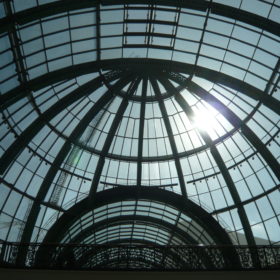
A South Korean research team has claimed that transparent PV technologies need to improve in terms of efficiency, stability and aesthetics before they can reach commercial maturity.
A research group from South Korea’s Ulsan National Institute of Science and Technology (UNIST) has published a roadmap that could help transparent photovoltaics (TPV) become a viable option for BIPV, solar window and electromobility applications.
They presented their findings in “The Development of Transparent Photovoltaics,” which was recently published in Cell Reports Physical Science. They proposed three issues that need to be addressed at the research level to bring TPV tech to commercial maturity.
Conversion efficiency
The first issue is the need for a significant increase in TPV conversion efficiency. “Some visible light-absorption-type TPVs currently reach a high-power conversion efficiency (PCE) of over 12% at an average visible transmittance (AVT) of 20%,” the scientists explained. “However, further research is required, such as modularization and scale-up of the unit cells (over 5 inches) for practical application.”
The researchers said large-area TPV devices could be easily manufactured, as the size of the LSC-type is only determined by the area of the transparent substrates in which the luminescent material is embedded. In order to understand how higher efficiencies could be achieved, scientists should investigate the performance of opaque PV, which offers lower light transmittance but higher efficiency.
“The PCE measurement method must be optimized for the TPV and standardized to avoid the overestimation of the PCE by eliminating reflection or scattering from the backside of the PCE measurement systems,” they said, adding that new strategies are also needed to minimize PCE degradation.
Aesthetic considerations
Another important challenge that must be addressed with TPV is integration with the aesthetic requirements of buildings. Researchers need to prioritize the development of neutral-colored TPV products that do not detract from the aesthetics of such applications.
Aesthetic elements such as transmittance and color must be thoroughly analyzed, as the haze ratio can confirm the degree of clearly visible transmitted light. The haze ratio is the difference between the scattered flux of light to the total flux of light transmitted through PV glass.
“In addition, for the color analysis of TPVs, the color rendering index (CRI) and the CIELAB color coordinate, which is specified by the International Commission on Illumination (CIE), should be considered for a clear comparative analysis,” the UNIST research team said.
CIELAB is the mainstream color space coordinate system that was defined by the International Commission on Illumination (CIE) in 1976. The CRI, meanwhile, is an index measuring the ability of a light source to reveal the colors of objects in contrast to natural light sources, such as sunlight passing through a windows.
Stability concerns
Long-term stability is the third pillar of the proposed UNIST roadmap.
“Because TPVs would be a part of the target applications, the stability of TPV is more critical than that of the commercial opaque PV, which are independently installed on land or the rooftops of buildings,” the team said. “However, studies on TPVs have so far mainly focused on improving the PCE.”
The researchers also proposed a series of strategies to drive down the costs of TPV products. They include the achievement of high efficiencies at the same AVT and the minimization of efficiency degradation due to the angle of light incidence. They also suggested focusing on the application of neutral colors and low transmission haze ratios similar to glass, as well as the modularization of TPV device production. In addition, future should focus on the development of flexible, lightweight, and inexpensive encapsulation materials that are transparent.
Crystalline silicon
TPV products based on crystalline silicon are currently the best candidates for commercialization, the researchers said.
“Currently, c-Si TPV show a PCE of up to 12.2% (AVT of 20%), which is the highest among neutral-colored TPV,” they explained. “Further, the stability is expected to be the same as that of commercial c-Si PV.”
However, cell technologies should be sized above 5 inches, they added, while arguing that modularization will be necessary to achieve the required current and voltage. “In the modularization process, it is challenging to maintain the transparency of unit cells when connecting electrodes,” they said.
Despite numerous issues with TPV technology, the scientists said that it could be a game changer for the global solar market.
“When the windows of a building with a window-to-wall ratio of 55% is replaced with 30 W TPV (AVT of 15%), more than 40% of the energy consumed in the building can be generated from the PV,” they concluded. “In addition, TPV could be applied to vehicles.”
Lắp đặt điện mặt trời Khải Minh Tech
https://ift.tt/2X7bF6x
0906633505
info.khaiminhtech@gmail.com
80/39 Trần Quang Diệu, Phường 14, Quận 3
Lắp đặt điện mặt trời Khải Minh Tech
https://ift.tt/2ZH4TRU
Không có nhận xét nào:
Đăng nhận xét